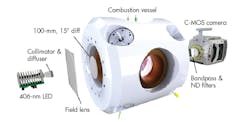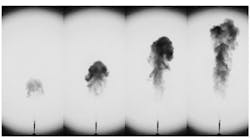Engine Optics Open Doors to Fuel Research
To meet future mandates on soot without sacrificing fuel savings, engine developers need advanced combustion strategies that reduce the formation of soot in spray flames.
“The data we are gathering yields important insights into fuel-spray motion, as well as the timing and quantity of soot formed under a wide range of conditions,” says Sandia researcher Scott Skeen. “Engine developers can use this information to validate computer models and design advanced combustion strategies that improve fuel economy for consumers while also lowering tailpipe pollutant emissions.”
The optical setup quantifies soot formation in high-pressure spray flames created in Sandia’s optically accessible, constant volume, pre-burn combustion chamber.
Imaging flames at temperatures and pressures found in engines can be difficult because of a phenomenon called “beam steering.” This occurs when light passes through a medium with varying refractive indexes; it’s commonly observed as “mirages” on the highway in the summertime. The hot pavement heats up nearby air, causing its refractive index to change. The sunlight changes direction as it passes from cooler through hotter air, and the steered light rays give the impression there is water on the road—a mirage.
Similarly, a flame causes beam steering because of adjacent high- and low-temperature regions. The magnitude of beam steering increases significantly in an engine due to the high pressures. With the right lighting and imaging optics, however, the effects of beam steering can be eliminated.
The special lighting was provided by a custom engineered diffuser large enough to fill Sandia’s spray combustion chamber window (4 in. or 100 millimeters). The diffuser emits light rays with the same brightness over a specified angular range. In this way, a light ray that gets steered as it passes through the flame will be replaced by another ray having the same intensity.
The angle of the diffuser is based on the physical dimensions of the experimental facility, the magnitude of the anticipated beam steering, and the collection angle of the imaging system. The researchers could never quantify the soot without the diffuser.
Although new diesel vehicles are cleaner than ever before, some of the latest-generation gas engines emit as much particulate matter as older diesel engines. The increased soot can be attributed to the adoption of direct-injection fuel, which improves fuel economy and therefore lowers CO2 emission per mile driven.
Direct injection involves spraying high-pressure liquid gasoline directly into the engine cylinder rather than mixing and vaporizing fuel in the intake port outside the cylinder. This reduces heat losses and allows for freer airflow. However, consumer savings at the pump come at the cost of higher soot emissions. Unlike the much-maligned black smoke emitted from older diesel engines, soot from direct injection engines is invisible to people because of the particles’ small size.
The optical technique used at Sandia relies on light attenuation or extinction to quantify the amount of soot in a flame. As light enters the combustion vessel, it is absorbed or scattered by soot particles. Light that is absorbed and some light that is scattered do not reach the camera. This reduction in measured light intensity relative to a clear optical path is related to the amount of soot present.
To make this diagnostic tool more convenient to researchers located across the world, Sandia provides detailed guidance on the necessary equipment and instructions for sizing the illumination source and collection optics. For example, using a Sandia-developed LED, as opposed to a high-speed laser, means the cost and complexity are significantly lower.
This goal of the Sandia team is to establish a standardized experimental method of extinction imaging that will increase the reliability and reproducibility of experimental measurements done in other labs.



